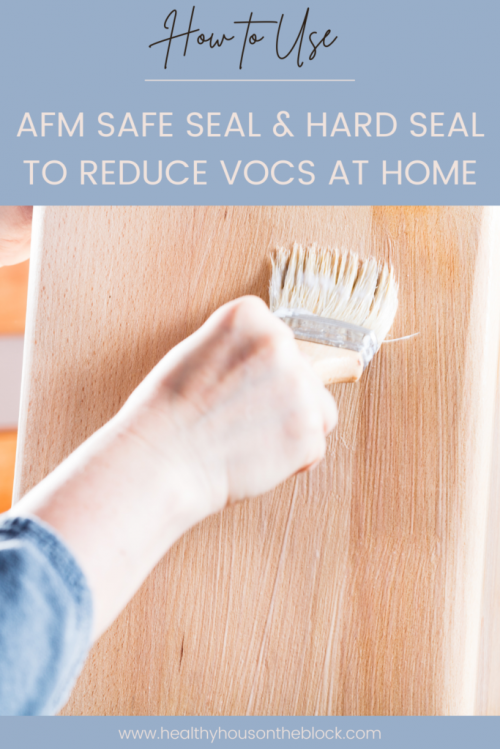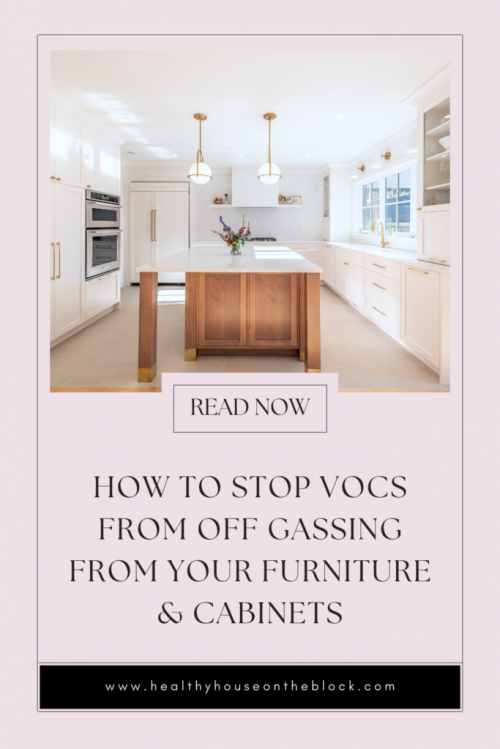
So many of us live in homes where there is plywood, manufactured wood and particleboard everywhere. Whether your home was just built or you live in a home built 100 years ago, likely there are these types of toxic materials inside your home and space. And while plywood, particleboard and other pressed woods are toxic in nature, there’s virtually no way for us to remove them from our homes. So what can we do to reduce the VOCs that off gas into our space? One of the products that I recommend on a regular basis is AFM SafeCoat Safe Seal.
I can’t tell you just how often I get emails and messages raising concern about the amount of VOCs, formaldehyde and off-gassing that happens inside our homes. We all want to figure out how to reduce as many VOCs as possible inside.
One way to do that is to reduce the amount of plywood and particle board in our homes. This means our home’s building materials, our cabinets and our furniture. But these are BIG ticket items to replace, and are not only costly, but it may be difficult to find a good replacement in a timely fashion.
Not to mention, there’s no reason to discard perfectly good furniture, cabinets or do unnecessary renovations to your home. It can be costly and wasteful to take this route. And this is exactly why I am a firm believer in AFM SafeCoat Safe Seal for stopping VOCs from off-gassing in your home. All you need is a paint brush and some time to make what you have a healthier option for your home.
This post will cover what this product is, how to get it and how to use it. Plus I’ll share some additional ways you can work with what you have to prevent the off-gassing of VOCs inside your home. The goal here is not to replace all your home’s contents, but to work with what you have in order to create a healthier space for you and your family.

WHAT IS SAFECOAT SAFE SEAL?
SafeCoat Safe Seal by AFM is a water based product that is used to coat materials like plywood, OSB, pressed wood or particle board that contains toxic VOCs such as formaldehyde. Safe Seal is a matte finish product and sticks well to porous surfaces.
It is best used on porous surfaces like plywood or exposed particleboard. They recommend using it on areas that aren’t often handled as the surface can remain a bit tacky even after curing.
Safe Seal should never be used over paint (I’ll share other products you can use for sealing in toxins on painted surfaces later in this post). However, you can use Safe Seal as a primer underneath the paint of your choosing.

WHY SHOULD I USE AN OUTGASSING SEALER?
Pressed woods, including plywood, particle board, and medium density fiberboard, all contain adhesives that keep the wood and particles intact. The adhesive used in these products contains VOCS, or organic volatile compounds, which will off-gas into the air.
The most harmful of these VOCs used in adhesives is formaldehyde, which is recognized as a known carcinogen by the EPA.
This post that I did last year can give you more information on VOCs. Essentially, there are SO many different VOCs that all cause damage to our bodies.

- Benzene: A highly flammable VOC and used in Can cause anemia, and issues with bone marrow as well as a human carcinogen (SOURCE).
- Ethanol: The most common VOC in cosmetics and beauty products as it helps to clean skin and acts as a preservative. It also helps products adhere to the human body. Can cause respiratory issues (SOURCE)
- Formaldehyde: Used in a variety of applications from personal products to building materials. It acts as a preservative and as a bonding agent. It has been linked to long term health issues with the sinuses and respiratory system as well as being a human carcinogen (SOURCE)
- Methylene Chloride: This VOC is most commonly found in varnishes and coatings. It can cause chronic dermatitis as well as permanent nerve and liver damage. It is a possible carcinogen to humans, but more research needs to be done. (SOURCE)
- Acetone (also known as propane): Most commonly used in nail polish remover, it is used to reduce the viscosity of solutions and helps “blend” a variety of solutions. Acetone can cause issues with the blood, as well as damage to the kidneys, liver and nerves. (SOURCE)
- Carbon Disulfide: Linked to reproductive effects (like decreased sperm count and disturbances in the menstrual cycle) as well as neurological effects resulting in behavioral changes. (SOURCE)
- Dichlorobenzene: Usually used as a repellent for insects, rodents and a deodorizer for bathrooms and nurseries. It has been linked to negative affects of the lungs and blood cells as well as cause damage to the liver and kidneys. (SOURCE)
- Toluene: Helps to dissolve other thick substances. A human carcinogen (SOURCE) as well as chronic effects on the central nervous system like tremors, involuntary eye movements and impaired speech, hearing or vision. (SOURCE)
- Xylene: Used in many glues, cleaning products, paints and sealants.. Xylene can be linked to chronic dermatitis, depression, headaches, insomnia, irritability and damage to the kidneys and liver. (SOURCE) It also a human carcinogen (SOURCE)

HOW TO USE SAFECOAT SAFE SEAL
It’s important to note that Safe Seal should ONLY be used on unfinished surfaces. Safe Seal is a very soft sealant and when applied in a few coats (which is recommended), it will remain a bit tacky.
Safe Seal is ideal for surfaces that won’t end up being touched or handled. You could apply it to plywood in building materials that will be covered up with finishes or in furniture pieces that have a plywood or pressed wood at the interior of the furniture. You may find an exposed edge that has not been finished on pressed wood furniture that you could seal in with Safe Seal.
Before you start it’s a good idea to spot-test in one area first to ensure you are happy with the finish and product. You’ll then want to clean the surface you’ll be painting and let it dry completely before you adhere the Safe Seal to it.
Safe Seal has a milky liquid appearance and texture but does dry clear. You’ll want to paint on with a brush, roller or sponge and let it dry completely (about two hours). You’ll then repeat this for 2-3 coats total. A thick application or a humid climate may create longer curing times. You can then clean up with warm soapy water while your tools are still wet.
The surface of the Safe Seal will remain a bit tacky, even when cured, which is why this is ONLY for surfaces that are not often touched or handled.
If you’re looking for options that can be used on finished pressed wood surfaces, I’m sharing that below.

OTHER OPTIONS TO REDUCE OFF GASSING
If you’re looking to seal in VOCs on painted and finished surfaces, that is possible, just not with Safe Seal. The options below are great options that will have a harder seal and are appropriate for surfaces that get a lot of use.
AFM SafeCoat Hard Seal: Hard Seal works in the same way as Safe Seal to encapsulate the toxins of a product. The difference is that Hard Seal is a clear gloss sealer that works on finished surfaces as well. It’s not recommended for hardwood floors and should not be used over oil-based polyurethane products or oil based products. It’s recommended that two coats are applied to ensure off-gassing VOCs are blocked.
AFM SafeCoat Acrylacq: Acrylacq is a more durable finish than Hard Seal and comes in either a satin finish or a gloss finish. It’s a great option for painting over surfaces that are already painted like cabinets. Make sure you’re not using this on oil based products, however. It’s best used on wood products.
AFM SafeCoat Polyureseal BP: Polyureseal is pretty much the same as the Acrylacq, except that the finish is more of an abrasive resistance, meaning it’s perfect for floors. Again, however, you don’t want to use this on polyurethane products. You’d have to sand it down before adhering this product to it.
However you decide to go about reducing VOCs through encapsulating a material, you’re doing your house and your health a BIG favor. Safe Seal and these other products are excellent when you want to preserve what you already have at home and make it healthy at the same time.








Does sherwin william carry an equivalent to safecoat to encapsulate?
Hi Heather! No, Sherwin Williams doesn’t have a product that is comparable to safecoat in that way, unfortunately.
Hi there,
I have an unfinished plywood shed that is new/offgassing. Im looking to apply something to the inside to make the plywood off gas outside. What would you recommend using?
Hi! Check out the AFM Safecoat for a VOC blocker.
Can this product be used on a particle board floor underlayment? It is particle board on top of subfloor and under carpeting right now. We want to remove the carpet and padding, clean up and seal the particle board, and install carpet tile after the sealant is cured.
That is an absolutely ideal situation to use Safecoat!
So does this work well on subfloors? I think my subfloor has been offgassing, I’d like to take up my flooring and put this over the subfloor.
Plywood subfloors is one of the BEST applications for this product as it ends up being covered up (so it won’t be a high-touch surface).